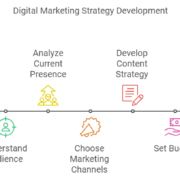
Thanks to the rising boom of software development, the need for efficient configuration management has also increased. This will allow businesses to keep up with the system updates while making sure it works smoothly with less downtime. By implementing DevOps tools, configuration management has become an easy task for teams to manage complex infrastructure. Due to the widespread availability of these tools, it can be difficult to select the correct tool that meets your business requirements. By 2024, some 78 percent of global organizations were using DevOps. In 2023, about 54 percent of those will be configuration management companies that use Ansible, Puppet, or Chef, which are fundamental to automating infrastructure, cutting costs, speeding up work, and ensuring consistency across environments from development through to production—and fundamental to the proliferation of DevOps across the world. In this article, you will read about the six best DevOps tools that make configuration management easier and their strong and weak sides to make the right choice.
Recently Added Article – Big Data in Healthcare
| Reach out to Spiral Mantra to get comprehension support for integrating DevOps tools, based on your business needs. By aligning best DevOps practices, we help businesses to drive innovation, improve productivity, and reduce time-to-market. |
What Are DevOps Configuration Management Tools?
DevOps configuration management tools are software-based solutions designed to automate the processes of managing and maintaining the state of an organization’s infrastructure and applications. Configured once in a DevOps configuration management tool’s UI, an organization’s infrastructure and applications can be rolled out across thousands of systems within minutes, eradicating the potential for the system to get up to date and fully functional within milliseconds.
Top 6 Configuration Management Tools Your DevOps Team Should Know
Ansible
Ansible, a free tool ideal for configuration management by reducing the need for manual intervention. When you decide to deploy or automate your task, this tool is something you can try and vouch for. Supports the configuration language of YAML, Ansible could be the best choice for you.
Pros:
- The tool is best known for seamless work, resulting in less complexity with deployment.
- YAML makes the process of writing configuration files easy.
- Ansible can manage multiple nodes, making it suitable for both small and large-scale deployment.
- Ansible has a big code base, making it ideal for wide adoption.
Cons:
- Although Ansible is easy and effective to use, sometimes it gets slower with other powerful tools.
- Easy to function, but sometimes causes glitches and makes your tasks more complex.
Also Read – Top 10 Predictive Analytics Tools to Strive in 2024
Puppet
Puppet is another effective configuration management DevOps tool you can have faith with. Simply, describe your requirements, including what kind of infrastructure you want, and then let Puppet do their work. The tool comes with a large module library and offers the benefits of a strong community network.
Pros:
- Puppet is best known for using declarative language, letting you simplify your work tasks.
- Supports a scalable and configured model that can effectively manage large-scale environments.
- Suitable for large infrastructure and enterprises.
- Effective infrastructure management helps you to enforce policies straightforwardly.
Cons:
- Requires an agent when implementing each node, resulting in increased cost.
- Although Puppet is an open-source version, most of its features are still accessible only at the condition of pay-per-use.
Chef
Another great declarative configuration management DevOps tool, Chef is based on Ruby DSL for modeling and configuration. The platform is known to use a client-server model and can be effectively used to automate infrastructure. Talking about its pros, then there are many which you should consider.
Pros:
- Easy to define configurations with a set of great flexibility, Chef’s Ruby-based DSL is best for managing every complex environment.
- Chef was designed to work effectively and can easily manage complex environments to produce efficient enterprise infrastructure management.
Cons:
- Chef is complex and harder to learn, especially for beginners.
- By adopting Chef’s client-server model, large file sizes could be difficult to manage, affecting performance.
Terraform
Terraform is another astounding open-source tool that focuses on implementing infrastructure as code. While it works to orchestrate infrastructure in much the same way that Ansible and Puppet can, Terraform is often used exclusively for provisioning cloud infrastructure; however, that might be on various platforms.
Pros:
- Cloud-Agnostic: Since Terraform supports multiple cloud providers – Amazon Web Services, Azure, and Google Cloud—you can use the same tool to manage wherever your infrastructure winds up.
- Declarative Language: Terraform describes infrastructure using a declarative language, which is easy to define and manage as code.
- State Management: Terraform tracks the state of your infrastructure, so you can easily see what is changing, and ensures that everything is in sync.
- Rich Ecosystem: You can use lots of third-party providers and modules, making it easy to integrate with other tools and services.
Cons:
- Learning Curve: Terraform’s language is pretty simple, but there are nuances to managing the state and working with more complex infrastructure that are hard for beginners.
- Poor Configuration Management: Terraform is a great tool for provisioning infrastructure, but it is, perhaps, a poor choice for tasks that are more in the realm of configuration management (these should probably be done by tools such as Puppet, Ansible, and so on).
- Manual Interventions: Some manual intervention is necessary, particularly when controlling the state file, which can go out of sync and corrupt the DB if not sanitized after a failure.
Don’t forget to read! Is AI and ML worth the hype?
SaltStack
Developed by frequent HN commentators, SaltStack, colloquially known as simply Salt, is an open-source configuration management tool described as ‘lightweight, high-speed communication between servers, and powerful management of infrastructure at scale’. It uses a master-minion architecture, where a master node sends commands to minions, agents that run on every managed node.
Pros:
- Speed: One of the main advantages of Salt’s event-driven architecture is that commands are applied and processes take place in real-time. This makes Salt one of the quickest tools out there, with the ability to deploy configurations in minutes.
- Flexibility: Salt has both push and pull models for how to manage your configuration.
- Scalability: Salt is supposed to provide a distributed and scalable solution for environments. It is built for the needs of enterprises.
Cons:
- Complexity: Salt’s flexibility and feature set also make it very unwieldy to work with (not always a bad thing, depending on the level of knowledge you’re seeking), which can indoctrinate the inexperienced user in the ways of Salt from the outset.
- Documentation: Salt has very wide-ranging documentation but can be a bit of a drag to navigate around due to its depth of features.
CFEngine
Another reputed configuration management tool, CFEngine is another older tool in the market. It is still light and efficient and designed to maintain a broad base of large and complex infrastructures with a heavy focus on security and scalability.
Pros:
- CFEngine can manage thousands of nodes efficiently, making it ideal for large enterprises.
- CFEngine is the oldest tool on the market; its user base and community-generated documentation are mature.
- CFEngine has an absolute, maniacal fascination with (and early success in) security, and you might find it compelling exactly because of that. CFEngine could be a good agent for an employer with exacting security needs.
Cons:
- Learning Curve: CFEngine is hard to learn… deeply ingrained in a language and approach that takes some time and effort to come to grips with.
- Complexity in Setup: CFEngine’s first setup is very complex, and complex in large environments.
- Smaller Community Support: It has a smaller community than equivalent tools like Ansible or Puppet.
Conclusion
Oftentimes, configuration management can be the most difficult of the DevOps practices to implement. The right tools can not only drastically improve your DevOps processes and mindset; they can mean the difference between a maintainable and manageable infrastructure versus a chaotic mess. Ansible, Puppet, Chef, Terraform, SaltStack, and CFEngine each have their strengths and weaknesses, and one may fit your needs better than others based on factors such as simplicity and ease of use versus scale and performance. Regardless of which tool you choose, you’ll be in a better position to do your job well, with smoother operations and more reliable deployments based on a more positive culture and work environment—all achieved using DevOps.











